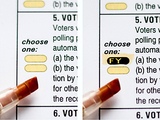Talk 10/31: Usable String Matching by Humans through Overlaid Presentation: Turning Syntactic Tasks into Perceptual Tasks
12:00–1pm, Friday, October 31, 2025 online
UMBC Cyber Defense Lab presents
Usable String Matching by Humans through Overlaid Presentation: Turning Syntactic Tasks into Perceptual Tasks
12:00–1pm, Friday, October 31, 2025 via WebEx
Alan T. Sherman, CSEE Department, UMBC
Joint work with Enka Blanchard, Ted Selker, Ryan Robucci, Levi Gabasova, and Mehdi Bouhamidi
Comparing two strings of characters is a basic activity that occurs in innocuous contexts (checking that an email address was entered correctly) and critical ones (from bank wire transfers to nuclear codes), where it is not always possible to trust a machine to perform the task. Because human performance on this task has received limited attention, we explore the limits and capabilities of humans to compare strings when presented in various formats. I am especially motivated by the important application of checking audit data in end-to-end voting systems including Scantegrity.
We present results from two online experiments with a total of 178 human subjects who compared pairs of text strings to determine for each pair whether the two strings are identical. Each subject was asked to complete 20 trials, which presented strings of 5, 10, or 15 characters or short nonsense sentences. For each pair, the strings were either identical or differed by one character (randomly changed or changed to be difficult to detect).
Our main insight was to check the difference between strings shown side by side, or overlaid in two colors. Our hypothesis is that, by turning complex syntactic tasks into simple perceptual tasks, such overlay formats can offer advantages in speed and accuracy in comparison with simple side-by-side presentations. Results show that, in comparison with side-by-side comparison, overlay offers a substantially faster method, with substantially improved accuracy for long strings, which has many applications including comparing fingerprints of cryptographic keys and establishing authenticity of authorization tickets.
Our work lays a foundation on which other new perceptual string-comparison strategies can be explored, such as using reflection to compare a string presented on a smartphone with one on a computer display monitor.
Dr. Alan T. Sherman is a professor of computer science at UMBC in the CSEE Department, associate director of UMBC's Cybersecurity Institute, and director of the Cyber Defense Lab. His main research interest is high-integrity voting systems. He has carried out research in election systems, protocol analysis, algorithm design, cryptanalysis, theoretical foundations for cryptography, applications of cryptography, cloud forensics, and cybersecurity education. Dr. Sherman is also a private consultant performing security analyses and serving as an expert witness. Sherman earned the PhD degree in computer science at MIT in 1987 studying under Ronald L. Rivest. His research accomplishments include contributions to the Scantegrity and VoteXX election systems and development and validation of the Cybersecurity Concept Inventory (CCI) and Cybersecurity Curriculum Assessment (CCA). This work has been presented at USENIX Security 2010 and E-VOTE-ID 2025, and won best research paper at SIGSCE 2023. Sherman received approximately $15 million in funding from NSF, NSA, and IBM.
Support for this event was provided in part by the NSF under SFS grants DGE-1753681 and 2438185. The UMBC Cyber Defense Lab meets biweekly Fridays 12-1pm. All meetings are open to the public.
Posted: October 22, 2025, 6:48 PM
